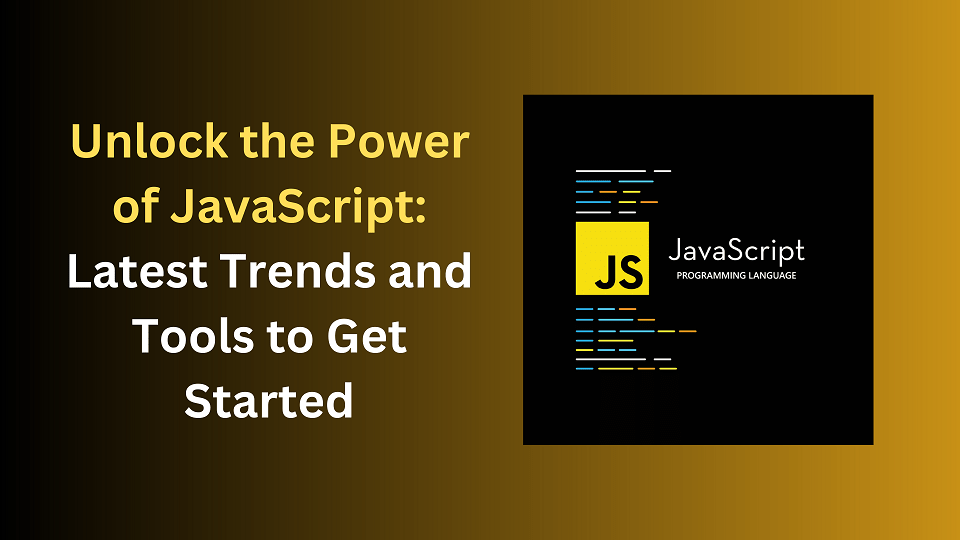Unlock The Power Of Javascript – Latest Trends And Tools To Get Started
There is a dynamic setting where JavaScript plays the lead role. This setting occurs in the digital arena, where technology is king and innovation is the path forward. Because of its dynamic nature, JavaScript is always pushing the limits of what is feasible.
As a result, it provides programmers with an ever-expanding toolset that enables them to bring their most imaginative concepts to life. An increasing number of open-source JS frameworks and libraries are used in the development of at least 80% of all applications written in the language.
It becomes clear that React, Angular, and Vue.js are the giants, with each offering a distinctive strategy for the construction of dependable and dynamic online apps. Their component-based architectures and virtual DOM manipulation provide developers the ability to design engaging interfaces that capture consumers and give their digital creations a sense of life.
However, the effect of JavaScript is not limited to the front end alone. In addition, the JavaScript community grows thanks to a large number of open-source projects and package managers such as npm and yarn. These ecosystems include a wealth of pre-built modules and libraries, which enables developers to use already existing solutions and speed up the development process.
Because the environment of JavaScript web development is always shifting, it is essential to keep up with the most recent developments in both trends and technologies. Therefore, let’s look forward to the most interesting developments ad tools in JavaScript in 2023.

Now That We’ve Gotten That Out Of The Way, Let’s Discuss The Top 12 Developments In Javascript:
1. React stays on top
Did you know that in 2022, just after Node.js, React was the most popular framework? Facebook created the React package in 2011 because it required a way to adapt to the ever-changing volume of users using its services.
In 2022, Node.js was not only the most popular JS framework among developers, but it also ranked first among the most popular web frameworks. The first iteration of what would eventually become React was called FaxJS.
Not until now has there been such a library that was both comprehensive and user-friendly. This release of React simplified the process of creating user interfaces for programmers.
Time passed, and in 2013, Facebook and the developer community began jointly maintaining the React framework as an open-source project. Thanks to the hard work of its maintainers, the React library for JavaScript developers has swiftly moved to the top of the charts. Pinterest, WhatsApp, Instagram, Reddit, Netflix, and many other industry leaders are among the many that have adopted React.
As of 2022, the Node Package Manager for JavaScript (commonly known as the React npm package) remains the most widely used. And for a good number of years, it has been quite well-liked. In addition, it has consistently been quite well-liked during its whole existence. It’s the most stable of the current JS tendencies.
2. Demand increase for Node.js
In a short length of time, Node.js has risen to become one of the most popular programming languages. This allowed developers to build scalable apps much more rapidly and easily. It’s used to create both user-facing and server-side applications.
The 2022 download year was another year of growth. The rapid adoption of Node.js begs the question: why? Faster development is possible and the resultant solutions are very effective because of their flexibility.
The JavaScript runtime environment enables the creation of code that is both efficient and flexible. Adding extra nodes vertically or more resources horizontally is a simple way to increase the capacity of a web application. Because of the modular nature of the framework, changes to the project may be done with little to no impact on the whole system.
3. Vue’s progress is ongoing
Vue.js and React are two popular options for front-end frameworks, and it may be difficult for developers to decide which one to employ. Vue.js is famous for a number of reasons, including its modularity, adaptability, and forward-thinking nature. There’s also a strong community behind it and a wealth of helpful documentation.
Vue.js version 3.2.45 was released to the public in 2022. Version 3.3 of the Vue.js framework has now entered development. It has already boosted TypeScript support, decreased bundle sizes, and increased application performance.
4. TypeScript’s popularity is rapidly growing
One example of the latter is Microsoft’s TypeScript, a programming language that was released in 2012 and is a superset of JavaScript. The fact is that JS does not restrict the sources from which design ideas may be borrowed.
As the name suggests, this programming language allows for optional types, while JS does not. TypeScript also provides enums, another handy tool for arranging code.
TypeScript borrowed both the syntax and the semantics of JavaScript. And it came with several more features that JavaScript programmers had been asking for. This language improves developer efficiency and makes it easier to organize big codebases.
5. Angular improves both efficiency and user comfort
Despite the language’s complexity, Angular is often used for big, enterprise-level projects. The Angular team is constantly updating this framework so that it can use the most current advancements in JavaScript.
In 2022, Angular 14 was released. In addition to several bug fixes, new features, and enhancements were provided by the Angular community in the latest release.
More tree-shakable error messages emerged, for instance, with the introduction of the router-strong type. Developers are now able to create more streamlined solutions thanks to the new techniques that expedite the development process.
6. The growth of Svelte only continues to speed up
Using a component-based design as its foundation, Svelte is a front-end framework. The first version of this framework was created in JavaScript and released to the public in 2016. However, the 2019 third edition makes use of TypeScript. Svelte will undoubtedly be one of the most talked about JavaScript styles of 2023.
Since the TypeScript version became released, this framework has received a lot of interest from the software development world. When it comes to frameworks, Svelte is among the finest and can accommodate the demands of the vast majority of developers.
7. Millions of people utilize Jamstack
Jamstack is a web development solution stack that facilitates the creation of reliable and speedy programs. Jamstack, a word created by Netlify, has supplanted the JAM. It now often denotes an all-encompassing method of designing websites that makes use of many different libraries and techniques.
Jamstack’s community survey found that 47% of its developers work on “edge-dynamic” websites. In addition, there are millions of users already signed up for these services.
Third-party application programming interfaces (APIs), such as those for user authentication and weather form submission, may be included in the solutions. You should have a fallback piece of code ready to go in case an external API stops working and your website goes down.
8. GraphQL is a tool for managing data collections
In 2015, Facebook unveiled GraphQL, a new query language. It may be used as a fuel source for JS programs.
This data management tool provides a flexible query syntax that may be used from the front or back end of the system. Many significant companies in the present day utilize it, including GitHub, Pinterest, Coursera, Shopify, and many more.
Several popular JavaScript frameworks and tools are available today that exploit data management. The majority of Internet traffic now comes from mobile devices, so making sure information loads fast and effectively is crucial.
Facebook’s desire to streamline data requests inside their own apps drove the creation of GraphQL. And GraphQL performed extremely well in that role.
9. Web components as primary building blocks
No one can predict how well-liked JavaScript frameworks will do over the next five years. On the other hand, web components are flexible enough to be used in almost every major framework or even in plain JavaScript.
Modern program parts are sometimes described as “framework agnostic” because of this. Agnostic web components are one proposed name for these pieces. They simplify website layout and reduce the price and development time of software.
10. Component-based architecture is the way to go
When employing a component-based architecture, the design is divided into numerous separate logical and functional parts. Common interface components like methods, properties, and events have concrete counterparts in these pieces.
The components of this design were thought to be reused as much as possible. Components are independently deployable binary units that contain the functionality.
We couldn’t pass up the chance to talk about Bit, an open-source platform while talking about the latest innovations in JS and front-end development in general. It’s a great resource for archiving, categorizing, and sharing the online assets created for any given project. It improves code reuse and makes it simpler to collaborate on different parts.
11. Accessibility and Inclusive Design
More and more businesses are realizing they need to make websites usable by people of all abilities, thus accessibility and inclusive design are receiving a lot of attention.
Some methods and resources that will keep this movement going are:
- To use semantic HTML, you must ensure that your content’s structure and meaning are communicated using the appropriate HTML elements and attributes.
- Using ARIA features in web apps to improve their accessibility.
- WCAG, or the online Content Accessibility principles, is a set of recommendations and principles for making online content accessible.
- The accessibility of your online apps may be evaluated and improved using tools like Lighthouse, axe, and WAVE.
In order for the web to really be accessible to all users, developers must make accessibility a top priority.
12. Motion and Interaction Design
Front-end developers now have the tools they need to build more dynamic and interesting experiences for their consumers thanks to the proliferation of current JavaScript frameworks and libraries.
As more and more developers place an emphasis on crafting enjoyable user experiences, motion, and interaction design will play an increasingly important part in the evolution of front-end frameworks.
The following are examples of widely used libraries and tools for animation and interaction design:
- GreenSock Animation Platform (GSAP)
- js
- Framer Motion
- React Spring
Tools to get started
How can one make the most of JavaScript’s features? The answer lies in existing frameworks and existing library materials. So, let’s introduce you to some of the best tools in the JavaScript community, which you may use to your advantage while writing your own code.
1. Vue.js
This framework’s stable release was made available on March 14, 2018. Three months have passed since this happened. It’s a PWA (progressive web application) that may be used to create stunning UIs. There will be no problems when integrating this with other libraries.
Vue is open-source and available at no cost. Vue’s numerous benefits include its low system requirements, small file size, plenty of useful tools, and quick learning curve. Single-page web apps may be made more aesthetically pleasing using Vue.
2. Babel
If you’ve ever wished you could use a JS feature before it was supported by any browsers, here is your chance. Babel is only an open-source JavaScript compiler.
As a consequence, your JavaScript code will be transformed into a format that works across several systems. It’s also meant to open the door to cutting-edge innovations like JSX.
3. Next.js
The construction is basic and the weight is low. You may use it in single-page apps since it will speed up page rendering. It achieves it by decomposing your code into smaller chunks, which speeds up page loads. It also allows for Hot Module Replacement to be used without issue. It’s also adaptable to your specific needs.
Next.js is also compatible with express and other HTTP-based Node.js servers. What do you like best about it? When used in conjunction with REACT, new capabilities become available.
4. Webpack
Webpack can help with module bundling. Using this, keeping track of your many JavaScript and style files will be a breeze. You may also bundle other things like code and images in addition to JS.
You should give it a try if you’re interested in streamlining any of your work processes. You’ll obtain an efficient and time-saving path.
5. React.js
For creating polished UIs, this library is indispensable. It may be adapted to many situations and is still quite effective. It may be combined with a broad range of different frameworks and libraries.
A sizable population is using React. It’s still widely read today, despite the fact that it came out five years ago. Facebook and other independent developers work together to keep React updated and secure. Start your no-cost, in-the-field testing now using React and Redux.
6. GraphQL
GraphQL is a query language developed for the express purpose of generating deeper inquiries. We often face problems associated with over- and under-fetching. These concerns are less pressing on smaller platforms like Facebook, but they still need to be addressed. Using GraphQL, we can efficiently get information from the database.
7. Jest
To put it simply, Jest is a JavaScript testing library. When used with other applications, it’s very much like Mocha. It has several useful features, such as “Snapshot testing,” which lets you try out various situations.
During “snapshot testing,” you capture a snapshot of your component as it now exists. Any further modifications to the component will need either rerunning the test or taking a new snapshot.
It’s also quite fast. When engaged, Jest’s code coverage functionality generates reports that show which files in your project aren’t being tested.
The learning curve for Jest is low, and it offers a wide range of configuration options. Moreover, the documentation is really well done.
Conclusion
In 2023, it’s obvious that JavaScript is here to stay, and its TypeScript fork is rapidly acquiring adherents. Recent advancements in JavaScript have been a driving force in the industry’s continued growth attempts. Developers will keep pushing the envelope of the web in search of better methods to make it more interactive and interesting for users.
In conclusion, new tools and trends that prioritize modularity, reusability, performance, accessibility, and pleasurable user experiences will determine the future of front-end development. You can hire a javascript developer, to help you to keep abreast of these changes that live up to consumers’ ever-evolving demands.





